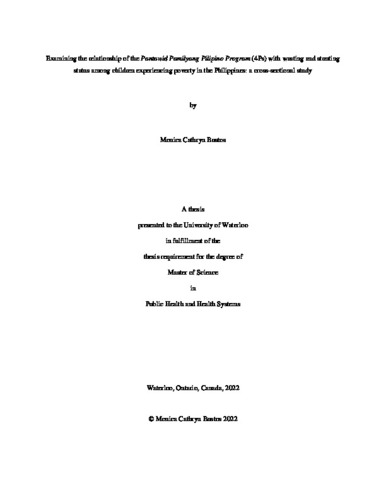| dc.contributor.author | Bustos, Monica Cathryn | |
| dc.date.accessioned | 2022-08-24 20:25:42 (GMT) | |
| dc.date.available | 2022-08-24 20:25:42 (GMT) | |
| dc.date.issued | 2022-08-24 | |
| dc.date.submitted | 2022-08-16 | |
| dc.identifier.uri | http://hdl.handle.net/10012/18638 | |
| dc.description.abstract | Background: In the Philippines, poverty is one of the main risk factors driving acute (wasting) and chronic (stunting) undernutrition among children. Previous research has pointed to the potential of social protection and conditional cash transfer programs to support the nutritional outcomes of children by improving the underlying determinants of health and nutrition. One such conditional cash transfer program in the Philippines is the Pantawid Pamilyang Pilipino Program (4Ps), which serves as the main social protection program in the country and aims to improve health and educational outcomes of children experiencing poverty.
Objectives: The conditionalities and entitlements from 4Ps has the potential to support the nutrition of children in participating households. Moreover, recognizing the similarities and differences in the drivers of and prevention approaches for wasting and stunting, it is important to understand the association of this conditional cash transfer program with these conditions. In collaboration with International Care Ministries (ICM), the objective of this study was to understand the association between household enrollment in 4Ps with wasting status and stunting status among children experiencing extreme poverty in the Philippines.
Methods: Secondary data analysis was conducted on cross-sectional survey data from ICM participants. A sample of 3,005 children aged between 6 months to 12 years were included in the analysis. Descriptive statistics were calculated to compare the sociodemographic characteristics of children from households enrolled and not enrolled in 4Ps, as well as children who were wasted and stunted. Two multilevel logistic regression models were used to estimate the association between household enrolment in 4Ps with wasting status and stunting status.
Results: Results from the descriptive statistics indicated that children in households enrolled in 4Ps had household heads with fewer years of education and more household members. In addition, there were no differences between the wealth and food insecurity of children from households enrolled and not enrolled in 4Ps. The regression modelling showed that there was no association between household enrollment in 4Ps and wasting status in children (adjusted OR=1.05; 95% CI=0.79-1.39). Conversely, household enrollment in 4Ps was significantly associated with stunting status (adjusted OR=0.50; CI=0.31-0.78), but this effect was moderated by geography type. Among children from households enrolled in 4Ps living in urban mountains, the odds of stunting were higher by a factor of 2.48 (95% CI=1.32-4.61) compared to children from households enrolled in 4Ps living in coastal areas. Similarly, children from households enrolled in 4Ps living in rural plains had higher odds of stunting by a factor of 2.24 (95% CI=1.30-3.82) compared to children from households enrolled in 4Ps living in coastal plains.
Conclusion: This cross-sectional study provides insight on the potential association of 4Ps with wasting and stunting among children. Findings indicate that 4Ps may not be able to address the underlying drivers of wasting. The results for wasting are consistent with previous research evaluating the relationship between 4Ps and wasting, but are different in contrast to the observed effects of unconditional cash transfers on wasting in different contexts. The effect moderation of geography type between the relationship of household enrollment in 4Ps and stunting in children may suggest that program benefits from 4Ps are not equitably distributed or that underlying risk factors may differ across different areas in the Philippines. The findings for stunting are aligned with previous research that have seen variation in the effects of 4Ps across different communities in the Philippines. Overall, these findings highlight implications for increasing adaptive capacity in 4Ps, ensuring an equivalent increase in supply-side resources, and integrating direct nutritional treatment to maximize the impact that this program can have on improving the nutritional outcomes of children experiencing poverty. | en |
| dc.language.iso | en | en |
| dc.publisher | University of Waterloo | en |
| dc.subject | global health | en |
| dc.subject | nutrition | en |
| dc.subject | social protection | en |
| dc.subject | children | en |
| dc.subject | poverty | en |
| dc.subject | cross-sectional | en |
| dc.subject | multilevel regression | en |
| dc.subject | conditional cash transfers | en |
| dc.title | Examining the relationship of the Pantawid Pamilyang Pilipino Program (4Ps) with wasting and stunting status among children experiencing poverty in the Philippines: a cross-sectional study | en |
| dc.type | Master Thesis | en |
| dc.pending | false | |
| uws-etd.degree.department | School of Public Health Sciences | en |
| uws-etd.degree.discipline | Public Health and Health Systems | en |
| uws-etd.degree.grantor | University of Waterloo | en |
| uws-etd.degree | Master of Science | en |
| uws-etd.embargo.terms | 0 | en |
| uws.contributor.advisor | Dodd, Warren | |
| uws.contributor.affiliation1 | Faculty of Health | en |
| uws.published.city | Waterloo | en |
| uws.published.country | Canada | en |
| uws.published.province | Ontario | en |
| uws.typeOfResource | Text | en |
| uws.peerReviewStatus | Unreviewed | en |
| uws.scholarLevel | Graduate | en |

